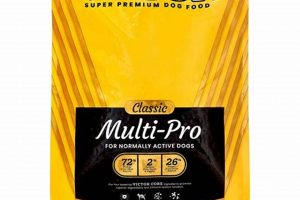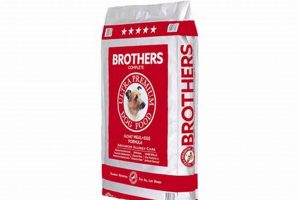A processed grain byproduct resulting from the rice milling industry, this ingredient consists of small fragments of rice kernels separated during the milling process. These broken pieces are often diverted for use in animal feed production. It is commonly found as a carbohydrate source in commercially produced canine diets.
Its inclusion in pet food formulations provides an inexpensive and readily digestible energy source. The manufacturing process helps break down complex starches, potentially easing digestion for some dogs. Historically, its utilization offers a means of upcycling an otherwise discarded element of food production, aligning with practices aimed at minimizing waste.
The subsequent sections will address the nutritional profile of this specific grain component, its potential advantages and disadvantages within canine diets, and considerations for pet owners in evaluating its presence in their dog’s food. These discussions will provide a more comprehensive understanding of its role in pet food formulations.
Considerations Regarding the Inclusion of Brewers Rice in Canine Diets
The following points outline crucial considerations when evaluating the presence of this specific ingredient in commercial dog food formulations. Understanding these nuances is essential for making informed dietary choices for canine companions.
Tip 1: Assess Overall Nutritional Profile: The presence of this ingredient should not be the sole determinant of food quality. Evaluate the complete ingredient list and guaranteed analysis to ensure the food meets the dog’s specific nutritional needs. A balanced diet includes protein, fat, vitamins, and minerals in appropriate proportions.
Tip 2: Consider Digestive Sensitivity: Some dogs exhibit sensitivities to certain grains. Monitor the dog for signs of digestive upset, such as loose stools or excessive gas, after introducing a food containing this ingredient. If symptoms persist, consult a veterinarian.
Tip 3: Evaluate Fiber Content: While it provides some fiber, it is generally lower in fiber compared to whole grain options. If the dog requires a higher fiber diet due to digestive issues or other health concerns, choose a food with alternative fiber sources.
Tip 4: Consult with a Veterinary Professional: Seek guidance from a veterinarian or a board-certified veterinary nutritionist. They can provide personalized recommendations based on the dog’s age, breed, health status, and activity level.
Tip 5: Understand Ingredient Sourcing and Processing: Inquire about the source and processing methods employed by the pet food manufacturer. Reputable companies often provide information regarding quality control measures and ingredient origins.
Tip 6: Compare with Whole Grain Alternatives: Compare dog foods containing this ingredient with those formulated with whole grains like brown rice or oats. Evaluate the nutritional benefits and potential drawbacks of each option in relation to the dog’s individual needs.
In summary, awareness of the potential benefits and limitations associated with this ingredient, combined with veterinary advice and careful observation of the dog’s response, is crucial for making sound dietary decisions.
The final section will synthesize the information presented, providing a concluding perspective on the role of this ingredient in canine nutrition and offering final recommendations for pet owners.
1. Source
The source of brewers rice directly impacts its quality and nutritional consistency within canine diets. As a byproduct of the rice milling industry, specifically from the production of polished white rice for human consumption, its composition varies depending on the original rice grain, milling techniques, and storage conditions. The origin dictates potential contaminants and the degree to which essential nutrients may be preserved or degraded. For example, if the source rice is treated with pesticides or herbicides during cultivation, residues may be present in the resulting brewers rice, potentially affecting canine health. Furthermore, inadequate storage of the rice prior to milling may lead to fungal growth, producing mycotoxins, which pose a serious risk. Therefore, pet food manufacturers must implement rigorous sourcing and quality control measures to ensure the safety and suitability of this ingredient.
Understanding the geographic origin can also offer insights into the milling practices employed. In regions where rice is a staple food, established milling facilities and quality standards may be more prevalent, increasing the likelihood of consistent, high-quality brewers rice. Conversely, reliance on smaller, less regulated milling operations may result in greater variability and potential for contamination. Transparency regarding the sourcing of this specific grain component allows pet owners to make informed decisions about the quality of their dog’s food. Certifications such as organic labeling or adherence to specific industry standards further contribute to confidence in the integrity of the source.
In conclusion, the source represents a foundational element in determining the safety and nutritional value of this grain component in dog food. Vigilant sourcing practices and stringent quality control measures are essential to mitigate risks associated with contaminants and ensure consistency in the ingredient’s composition. Pet owners are encouraged to prioritize brands that demonstrate transparency regarding ingredient origins and adhere to established quality standards.
2. Digestibility
The digestibility of brewers rice within canine diets is a significant factor determining its nutritional efficacy. The milling process, which creates this ingredient, also alters its starch structure. This alteration generally leads to easier enzymatic breakdown during digestion, facilitating glucose absorption in the small intestine. Consequently, it can provide a readily available energy source for dogs, particularly those with sensitive digestive systems or those recovering from illness. However, the degree of processing affects digestibility; excessive heat treatment during manufacturing may denature proteins and carbohydrates, reducing their bioavailability. Additionally, individual canine physiological differences, such as enzyme production and gut microbiome composition, influence how efficiently they process brewers rice.
Poor digestibility manifests in several ways, including undigested food particles in feces, increased fecal volume, and flatulence. Chronically undigested carbohydrates can lead to bacterial overgrowth in the large intestine, potentially resulting in diarrhea or other gastrointestinal disturbances. For example, a senior dog with reduced digestive enzyme production might struggle to efficiently digest even the relatively processed starch in brewers rice, requiring smaller portions or alternative carbohydrate sources. Conversely, a healthy, active dog might efficiently utilize the energy provided by this ingredient without any adverse effects. Pet food manufacturers often use digestibility trials to assess the nutritional value of their formulations, providing insights into the percentage of nutrients absorbed by dogs.
In conclusion, while the milling process generally enhances the digestibility of brewers rice compared to whole grain rice, several factors influence its actual digestibility in dogs. Individual canine physiology, manufacturing processes, and the overall dietary context must be considered. Monitoring fecal quality and consulting with a veterinarian are essential steps in ensuring optimal nutrient absorption and minimizing digestive upset. A balanced approach, prioritizing high-quality ingredients and tailored feeding strategies, remains crucial for promoting canine digestive health.
3. Nutritional Value
The nutritional value of brewers rice in the context of canine diets is a critical consideration for pet food manufacturers and owners alike. While serving as a carbohydrate source, its contribution to overall dietary needs requires careful evaluation.
- Carbohydrate Content and Energy Provision
Brewers rice primarily provides carbohydrates, which serve as a readily available energy source for dogs. However, its carbohydrate content should be balanced with other essential nutrients, such as protein and fats, to meet the dog’s overall energy requirements. The glycemic index, although not widely studied specifically for brewers rice in dogs, implies it will contribute to blood sugar levels. This requires careful consideration for diabetic or overweight dogs.
- Protein and Amino Acid Profile
Brewers rice contains a relatively low amount of protein compared to other ingredients commonly used in dog food, such as meat meals or legumes. Furthermore, the protein it does provide may not contain a complete amino acid profile, lacking essential amino acids required for optimal canine health. Therefore, it must be supplemented with other protein sources to ensure the dog receives adequate amounts of all necessary amino acids.
- Vitamin and Mineral Composition
While brewers rice contributes some vitamins and minerals, it is not a significant source of micronutrients compared to ingredients like organ meats or vegetables. It may contain trace amounts of B vitamins and minerals such as iron, but these are typically present in low concentrations and may not significantly contribute to the dog’s overall vitamin and mineral intake. Fortification with supplemental vitamins and minerals is often necessary in dog food formulations that rely heavily on brewers rice as a carbohydrate source.
- Fiber Content and Digestibility
Brewers rice provides a modest amount of dietary fiber, which can contribute to healthy digestion and bowel function. However, it is generally lower in fiber compared to whole grain options like brown rice or oats. The digestibility of brewers rice is generally high, making it a readily available energy source. However, excessive amounts can lead to digestive upset in some dogs, highlighting the importance of moderation and a balanced diet.
In conclusion, brewers rice offers primarily carbohydrates and some limited amounts of other nutrients. It should be viewed as a single component within a broader dietary context. A nutritionally complete and balanced dog food formula will incorporate a variety of ingredients to provide all essential nutrients, with the specific role of this ingredient being to offer a digestible energy source. Careful attention must be given to the overall formulation to ensure dogs receive optimal nutrition.
4. Allergenicity
The allergenicity of brewers rice in canine diets is a relevant consideration, although this ingredient is generally regarded as less allergenic compared to common protein sources like beef or chicken. While true rice allergies are relatively uncommon in dogs, sensitivities or intolerances can occur. Understanding potential allergenic mechanisms and recognizing symptoms are crucial for pet owners.
- Cross-Reactivity with Other Grains
While rare, some dogs exhibit cross-reactivity between different grains. A dog sensitive to wheat or corn might also react to rice, including brewers rice, although the likelihood is lower due to differences in protein structures. Diagnostic testing performed by a veterinarian can help determine the specific allergens triggering a reaction.
- Presence of Storage Mites
Storage mites, microscopic organisms that thrive in stored grains, can contaminate brewers rice. These mites themselves are potent allergens. Even if a dog is not inherently allergic to rice, the presence of storage mites can trigger an allergic response. Proper storage of dog food and using products with airtight packaging can minimize exposure to these mites.
- Digestive Intolerance vs. True Allergy
Distinguishing between a true allergy and a digestive intolerance is essential. An allergy involves an immune system response, often manifesting as skin irritation, itching, or hives. Intolerance, on the other hand, typically presents as gastrointestinal upset, such as diarrhea or vomiting. Brewers rice may be poorly digested by some dogs, leading to intolerance rather than a true allergic reaction. Food elimination trials, guided by a veterinarian, can help differentiate between these conditions.
- Role in Elimination Diets
Brewers rice is sometimes used in elimination diets designed to diagnose food allergies in dogs. Because it is considered a novel ingredient for many dogs (meaning they haven’t been frequently exposed to it), it can serve as a safe carbohydrate source during the initial phase of the diet. However, if a dog has previously been exposed to brewers rice, it may not be a suitable choice for an elimination diet.
The potential for allergenicity, although relatively low compared to other ingredients, necessitates vigilance among pet owners. Observing dogs for signs of allergic reactions or digestive upset following the introduction of dog food containing brewers rice is essential. Consulting with a veterinarian for proper diagnosis and management of suspected food allergies is strongly recommended. While often included in hypoallergenic diets, caution and careful monitoring are still advised.
5. Cost Effectiveness
Brewers rice presents a cost-effective carbohydrate source within the commercial dog food industry. Its designation as a milling byproduct allows for its acquisition at a lower price point compared to whole grains or other carbohydrate sources. This economic advantage directly translates into reduced production costs for manufacturers, enabling the creation of more affordable pet food products. The effect of this lower cost is that manufacturers can maintain profit margins while offering competitive pricing to consumers, especially in budget-conscious product lines.
The importance of cost effectiveness manifests in the ability to provide accessible nutrition to a wider range of pet owners. For example, economy-grade dog food formulations often rely heavily on brewers rice to maintain affordability. While these formulations may not offer the same nutritional density as premium options, they still provide basic sustenance at a price point accessible to pet owners with limited financial resources. This accessibility is particularly significant in regions with lower average incomes or during periods of economic downturn. However, the reliance on this ingredient for cost reduction necessitates careful balancing with nutritional requirements to avoid compromising the overall quality of the food.
In summary, the cost effectiveness of brewers rice is a crucial factor influencing its widespread use in dog food manufacturing. This economic advantage allows for lower product prices and greater accessibility for consumers. However, the pursuit of cost reduction must be carefully balanced with the need to provide adequate nutrition to ensure canine health and well-being. Responsible pet food manufacturers prioritize both affordability and nutritional value in their formulations, recognizing the significance of each aspect in meeting the needs of both pets and their owners.
6. Filler Potential
The filler potential of brewers rice in canine diets arises from its relatively low nutritional density compared to other ingredients. Its primary contribution lies in carbohydrate provision, while offering limited amounts of protein, essential fatty acids, vitamins, or minerals. This characteristic necessitates scrutiny to ensure its inclusion does not displace more nutrient-rich components within the formulation.
- Dilution of Nutritional Profile
When brewers rice comprises a significant proportion of a dog food formula, it can dilute the overall nutritional profile. This displacement of more nutrient-dense ingredients, such as meat proteins or organ tissues, can result in a diet that does not adequately meet a dog’s specific nutritional needs. For instance, a food heavily reliant on this ingredient may necessitate extensive supplementation with synthetic vitamins and minerals to compensate for the lack of naturally occurring nutrients.
- Caloric Contribution Without Satiety
While providing calories, brewers rice lacks the fiber and protein content that promotes satiety. Consequently, a dog consuming a diet high in this ingredient may require larger portions to feel full, potentially contributing to weight gain. Furthermore, the rapid digestion of carbohydrates from this source can lead to blood sugar fluctuations, potentially exacerbating hunger and contributing to overeating.
- Indicator of Ingredient Prioritization
The prominent placement of brewers rice on a dog food ingredient list can serve as an indicator of ingredient prioritization by the manufacturer. Ingredient lists are typically ordered by weight, with the ingredient present in the highest quantity listed first. A high ranking for this ingredient may suggest that cost reduction, rather than nutritional optimization, is a primary driver in the formulation process.
- Impact on Stool Quality and Volume
Due to its lower fiber content compared to whole grains or vegetables, excessive inclusion can lead to increased stool volume and reduced stool quality. Higher starch content, without adequate fiber to promote gut motility, may result in poorly formed stools that are difficult to pass. Observing stool characteristics can provide insights into the digestibility and suitability of the carbohydrate sources used in a dog’s diet.
These facets underscore the necessity for careful evaluation when assessing dog foods containing brewers rice. While not inherently detrimental, its inclusion must be considered in the context of the overall formulation. A balanced approach, prioritizing diverse and nutrient-rich ingredients, is crucial for minimizing the filler potential and ensuring that canine diets meet all essential nutritional requirements. Prudent pet owners should prioritize ingredient quality and nutritional balance when making dietary choices for their canine companions.
Frequently Asked Questions Regarding Brewers Rice in Dog Food
The following questions address common concerns and misconceptions surrounding the inclusion of this ingredient in commercial canine diets. These answers provide factual information to aid in making informed decisions about pet food selection.
Question 1: Is brewers rice nutritionally complete for dogs?
Brewers rice is not a nutritionally complete food source for dogs. It primarily provides carbohydrates for energy and contains limited amounts of protein, fat, vitamins, or minerals. A balanced diet must include other ingredients to meet the canine’s nutritional needs.
Question 2: Is brewers rice an allergen for dogs?
While less allergenic than common protein sources, brewers rice can still trigger allergic reactions or intolerances in some dogs. Storage mites contaminating the rice are potential allergens. Digestive upset may also occur due to intolerance rather than a true allergy. Veterinary testing is advisable to confirm suspected allergies.
Question 3: Does brewers rice offer any health benefits for dogs?
Its primary benefit is providing a readily digestible source of energy. The milling process aids in starch breakdown, making it easier for some dogs to digest. However, other carbohydrate sources offer similar benefits and may provide higher nutritional value.
Question 4: Is brewers rice a “filler” ingredient in dog food?
Brewers rice can act as a filler if it displaces more nutrient-dense ingredients in a dog food formula. A high proportion of this ingredient, coupled with low levels of protein or other essential nutrients, suggests a potential filler role. Evaluate the complete ingredient list for a balanced nutritional profile.
Question 5: How does the cost of brewers rice affect dog food prices?
The lower cost of brewers rice, as a byproduct of rice milling, reduces manufacturing expenses. This contributes to lower prices for dog food products, particularly economy-grade options. However, affordability should not supersede nutritional adequacy.
Question 6: Should I avoid dog foods containing brewers rice?
Avoiding dog foods with this ingredient is not inherently necessary. The overall nutritional balance of the food is more important than the presence of any single ingredient. Consider the complete ingredient list, guaranteed analysis, and the dog’s individual needs when making dietary decisions. Consultation with a veterinarian is recommended.
These answers aim to clarify common points of confusion regarding the use of this grain byproduct in canine diets. Individual canine needs must be considered when assessing the suitability of any food formulation.
The subsequent section will present a concluding summary, synthesizing the information presented and offering final recommendations for pet owners.
Conclusion
This exposition has systematically analyzed the role of brewers rice in canine diets. It is fundamentally a carbohydrate source with limited nutritional contributions beyond energy provision. While generally digestible and cost-effective for manufacturers, its inclusion demands careful consideration to ensure it does not supplant more nutrient-rich ingredients. Allergenicity, although low, warrants vigilance, and its potential as a filler necessitates scrutiny of the overall dietary composition.
The ultimate determination of its suitability rests upon a holistic assessment of the dog food formula, individualized canine needs, and responsible decision-making by pet owners. Prudent evaluation, informed by veterinary guidance, remains paramount in safeguarding canine health and well-being. The presence of brewers rice should not be the sole determinant; rather, it should be viewed as one component within a broader dietary context requiring careful scrutiny and informed choice.







